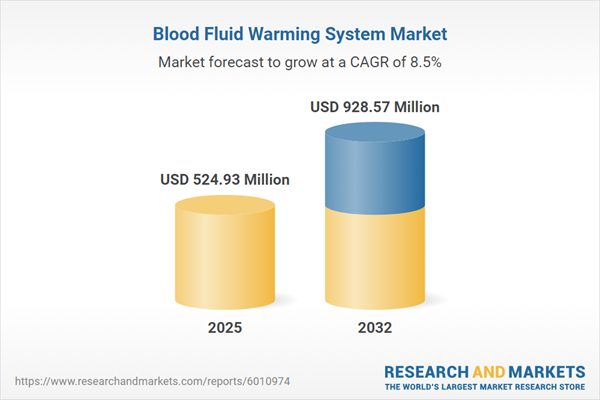Speak directly to the analyst to clarify any post sales queries you may have.
Advanced blood fluid warming systems are a cornerstone of modern healthcare, ensuring safer, more effective patient care in critical and surgical settings. As clinical standards rise and innovative solutions enter the market, these systems are increasingly integral to hospital operations, risk mitigation, and patient outcomes.
Market Snapshot: Blood Fluid Warming System Market Overview
The blood fluid warming system market grew from USD 483.33 million in 2024 to USD 524.93 million in 2025. It is expected to continue expanding at a CAGR of 8.50%, reaching USD 928.57 million by 2032. Consistent demand across developed and emerging healthcare sectors, combined with technological advancement and policy changes, is shaping procurement behaviors and investment decisions at both provider and supplier levels.
Scope & Segmentation of the Blood Fluid Warming System Market
- Product Types: Accessories, consumables, and systems, including fluid warming cabinets and inline fluid warmers, each tailored for specific clinical applications.
- Technology: Dry heat technology for ease of maintenance, resistive wire technology (both single and dual wire) for rapid response and granular temperature control, and water bath systems for uniform heat distribution.
- Application Areas: Critical care, emergency scenarios, and intraoperative environments, each demanding different device features and levels of portability.
- End Users: Ambulatory surgical centers prioritize compact and easy-to-operate devices, hospitals seek comprehensive support and advanced analytics, and specialty clinics value modular and cost-effective solutions.
- Regional Coverage: Americas (North America, Latin America), Europe, Middle East & Africa (Western Europe, Eastern Europe, Gulf region, selected African countries), and Asia-Pacific (China, India, Japan, Australia, emerging Southeast Asian markets).
- Leading Companies: 3M Company, Belmont Instrument Corporation, Baxter International Inc., Biegler GmbH, Acemedical Co., Ltd, Barkey GmbH & Co. KG, GE Healthcare, Haier Biomedical, Keewell Medical Technology Co. Ltd., and EMIT Corporation.
Key Takeaways for Decision-Makers
- Growing reliance on blood fluid warming systems is driven by stricter patient safety requirements and increasingly complex surgical procedures across hospitals and clinics.
- Technological innovation—such as hybrid warming modalities and integrated digital capabilities—is reshaping equipment standards and end user expectations.
- Adaptability in system configuration, including modular and portable designs, is emerging as a strategic asset for facilities with varied procedural demands.
- Investments in responsive service networks and predictive maintenance abilities distinguish market leaders and are highly valued by top healthcare purchasers.
- Collaboration is increasing between manufacturers, biomedical researchers, and clinical end users, resulting in devices that better support workflow integration and compliance mandates.
- Providers are seeking solutions that balance operational efficiency, total cost of ownership, and clear clinical benefits, fueling the need for transparent value propositions.
Tariff Impact: Navigating the 2025 Regulatory Landscape
With the implementation of new United States tariffs on imported components in 2025, manufacturers and distributors face increased production expenses and elongated supply chain timelines. Companies are shifting toward domestic sourcing, local manufacturing partnerships, and strategic supplier collaborations to offset price fluctuations and bolster resilience. Procurement strategies are evolving, with more healthcare networks negotiating long-term agreements and seeking hybrid purchasing models to ensure cost predictability and operational stability.
Research Methodology & Data Sources
A robust, multi-step research methodology supports this analysis. Experts conducted extensive secondary research—reviewing regulations, peer-reviewed studies, and technology filings—followed by in-depth interviews with hospital procurement managers, clinicians, and engineers. Quantitative surveys across a representative sample of end users allowed triangulation of insights. Analytical frameworks, including SWOT and Porter's Five Forces, informed segment and competitive evaluations.
Why This Blood Fluid Warming System Report Matters
- Enables strategic planning and resource allocation by providing actionable intelligence on product, technology, and end user trends in the blood fluid warming system market.
- Guides procurement and investment decisions with objective assessments of regulatory, tariff, and regional market shifts affecting supply chain stability and device adoption.
- Equips senior decision-makers with segment-specific insights needed to benchmark operational efficiency, align compliance efforts, and foster value-based care initiatives.
Conclusion
Continuous advancements in blood fluid warming system technologies, evolving regulatory frameworks, and the need for cost-effective, patient-centric care drive sustained innovation. Senior leaders who align procurement with both technological and clinical imperatives will secure performance and value in a rapidly transforming marketplace.
Additional Product Information:
- Purchase of this report includes 1 year online access with quarterly updates.
- This report can be updated on request. Please contact our Customer Experience team using the Ask a Question widget on our website.
Table of Contents
3. Executive Summary
4. Market Overview
7. Cumulative Impact of Artificial Intelligence 2025
Companies Mentioned
The companies profiled in this Blood Fluid Warming System market report include:- 3M Company
- Belmont Instrument Corporation
- Baxter International Inc.
- Biegler GmbH
- Acemedical Co., Ltd
- Barkey GmbH & Co. KG
- GE Healthcare
- Haier Biomedical
- Keewell Medical Technology Co. Ltd.
- EMIT Corporation
Table Information
| Report Attribute | Details |
|---|---|
| No. of Pages | 184 |
| Published | November 2025 |
| Forecast Period | 2025 - 2032 |
| Estimated Market Value ( USD | $ 524.93 Million |
| Forecasted Market Value ( USD | $ 928.57 Million |
| Compound Annual Growth Rate | 8.5% |
| Regions Covered | Global |
| No. of Companies Mentioned | 11 |









